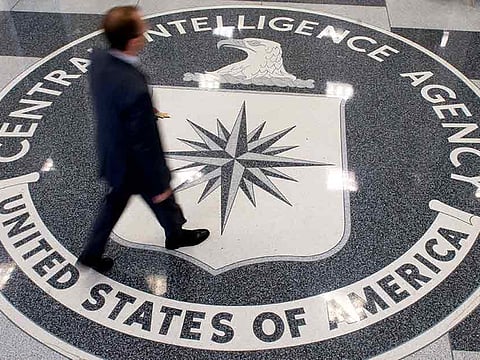Cash from CIA used to refill Al Qaida coffers
While refusing to pay ransoms for Americans, money has been siphoned off to enemy fighters

Washington: In the spring of 2010, Afghan officials struck a deal to free an Afghan diplomat held hostage by Al Qaida. But the price was steep — $5 million (Dh18 million) — and senior security officials were scrambling to come up with the money.
They first turned to a secret fund that the Central Intelligence Agency (CIA) bankrolled with monthly cash deliveries to the presidential palace in Kabul, according to several Afghan officials involved in the episode. The Afghan government, they said, had already squirrelled away about $1 million from that fund.
Within weeks, that money and $4 million more provided from other countries was handed over to Al Qaida, replenishing its coffers after a relentless CIA campaign of drone strikes in Pakistan had decimated the militant network’s upper ranks.
“God blessed us with a good amount of money this month,” Atiyah Abd Al Rahman, the group’s general manager, wrote in a letter to Osama Bin Laden in June 2010, noting that the cash would be used for weapons and other operational needs.
Bin Laden urged caution, fearing the Americans knew about the payment and had laced the cash with radiation or poison, or were tracking it. “There is a possibility — not a very strong one — that the Americans are aware of the money delivery,” he wrote back, “and that they accepted the arrangement of the payment on the basis that the money will be moving under air surveillance.”
The CIA’s contribution to Al Qaida’s bottom line, though, was no well-laid trap. It was just another in a long list of examples of how the US, largely because of poor oversight and loose financial controls, has sometimes inadvertently financed the very militants it is fighting.
While refusing to pay ransoms for Americans kidnapped by Al Qaida, the Taliban or, more recently, Deash, the US has spent hundreds of billions of dollars over the last decade at war in Iraq and Afghanistan, some of which has been siphoned off to enemy fighters.
The letters about the 2010 ransom were included in correspondence between Bin Laden and Rahman that was submitted as evidence by federal prosecutors at the Brooklyn trial of Abid Naseer, a Pakistani Al Qaida operative who was convicted this month of supporting terrorism and conspiring to bomb a British shopping Centre.
The letters were unearthed from the cache of computers and documents seized by Navy Seals during the 2011 raid, in which Bin Laden was killed in Abbottabad, Pakistan, and had been classified until introduced as evidence at the trial.
Details of the CIA’s previously unreported contribution to the ransom demanded by Al Qaida were drawn from the letters and from interviews with Afghan and Western officials speaking on condition of anonymity because of the sensitivity of the issue. The CIA declined to comment.
The diplomat freed in exchange for the cash, Abdul Khaliq Farahi, was serving as the Afghan consul-general in Peshawar, Pakistan, when he was kidnapped in September 2008 as he drove to work. He had been weeks away from taking up his new job as Afghanistan’s ambassador to Pakistan.
Afghan and Pakistani insurgents had grabbed Farahi, but within days they turned him over to Al Qaida members. He was held for more than two years.
The Afghan government had no direct contact with Al Qaida, stymieing negotiations until the Haqqani network, an Afghan insurgent faction with close ties to Al Qaida, stepped in to mediate.
Qaida leaders wanted some captive militants released, and from the letters it appeared that they calibrated their offer, asking only for men held by Afghan authorities, not those imprisoned by the Americans, who would refuse the demand as a matter of policy. But the Afghans refused to release any prisoners, “so we decided to proceed with a financial exchange,” Rahman wrote in the June 2010 letter. “The amount we agreed on in the deal was $5 million.”
The first $2 million was delivered shortly before that letter was written. In it, Rahman asked Bin Laden if he needed money and said “we have also designated a fair amount to strengthen the organisation militarily by stockpiling good weapons.” The Qaida leaders named in the letters were identified by aliases. Bin Laden, for instance, signed his letters Zamray; Rahman, who was killed in a drone strike in Pakistan in August 2011, went by the alias Mahmud.
In a letter dated November 23, 2010, Rahman reported to Bin Laden that the remaining $3 million had been received and that Farahi had been released.
The CIA, meanwhile, continued dropping off bags of cash — ranging each time from a few hundred thousand dollars to more than $1 million — at the presidential palace every month until last year, when Karzai stepped down.
The money was used to buy the loyalty of warlords, legislators and other prominent — and potentially troublesome — Afghans, helping the palace finance a vast patronage network that secured Karzai’s power base. It was also used to cover expenses that needed to be kept off the books such as clandestine diplomatic trips, and for more mundane costs, including rent payments for the guesthouses where some senior officials lived.
The cash flow has slowed since a new president, Ashraf Ghani, assumed office in September, Afghan officials said, refusing to elaborate. But they added that cash was still coming in, and that it was not clear how robust any current American constraints on it are.
“It’s cash,” said a former Afghan security official. “Once it’s at the palace, they can’t do a thing about how it gets spent.”
Sign up for the Daily Briefing
Get the latest news and updates straight to your inbox



